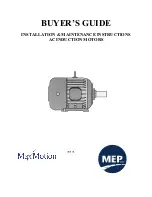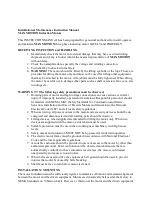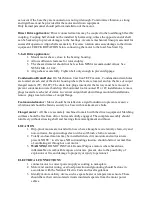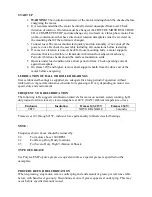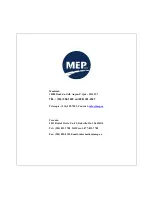
can occur if the base they are mounted on is not rigid enough. To minimize vibration, a strong
and rigid base must be provided for the motor and driven equipment.
Only trained personnel should perform installation of the motor.
Direct Drive application :
Direct connected motors may be coupled to the load through flexible
coupling. Coupling half should not be installed by hammering, unless the opposite end of shaft
can be backed up to prevent damages to the bearings. Accurate mechanical lineup is essential for
successful operation. Align shafts accurately. If reverse rotation can cause damage to the driven
equipment, CHECK ROTATION before connecting the motor to the load. See Start Up.
V-belt Drive application :
1.
Mount motor sheave close to the bearing housing.
2.
Allow sufficient clearance for rotor endplay.
3.
The sheave diameter should not be less than NEMA recommended values. See
NEMA MG-1-14.42.
4.
Align sheaves carefully. Tighten belt only enough to prevent slippage.
Condensation Drain Holes:
On MaxMotion Cast Iron TEFC motors, Condensation drain holes
are located at each end of the stator housing where the feet are located, and on the face of output
flanged motors (TC, JM, JP). The drain hole plugs inserted at the factory must be removed to
prevent condensation water build up. On horizontal foot mounted F1 or F2 installations, remove
plugs located at each end of stator. In vertical output shaft down flange mounted installations,
remove plugs located on face of output flange.
Foot mounted motor :
Motor should be installed on a rigid foundation to prevent excessive
vibration and should be fasten securely to a base with maximum size bolts.
Flanged motor :
All fits are accurately machined to match with the driven equipment. Matching
surfaces should be free from dirt or burrs and solidly engaged. The complete assembly should
turn freely without stressing shaft and bearings from misalignment and thrust.
LOCATION
1.
Drip-proof motors are intended for use where atmosphere is relatively clean, dry and
non-corrosive. Keep windings clean with a soft brush, cloth or vacuum.
2.
Totally-enclosed motors may be installed where dirt, moisture and corrosion are
present. NOTE
: in all cases, NO surrounding structure should obstruct normal flow
of ventilating air through or over motor.
3.
WARNING!
DO NOT INSTALL General Purpose motors where hazardous,
inflammable or combustible vapors or dust are present, due to the possibility of
explosions or fire and damage to property or injury to personnel.
ELECTRICAL CONNECTIONS
1.
connect motor to correct power supply according to nameplate.
2.
Motor and control wiring, overload protection and grounding should be done in
accordance with the National Electric Code and local regulations.
3.
Identify motor auxiliary device such as space heater or temperature sensors. These
should have their own isolated circuits insulated separate from the motor power
cables.

